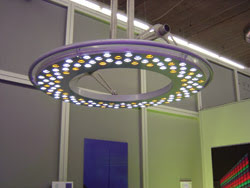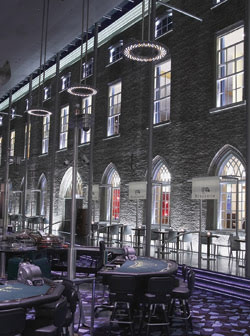Keith Scott, Lumileds Lighting LLC
Major advancements in LED technologies are making new lighting products and effects possible. Over the past few years, we’ve witnessed the advent of seven colors and a white LED in high-power packaging, along with silicon and plastic lenses that realize the promise of long-lifetime, high-lumen-maintenance LEDs. The market also has seen the emergence of a high-power “warm white” LED with a remarkable color-rendering index.

Figure 1. LEDs are employed in interior lighting in Holland Casino Breda.
High-power LED packages already are finding a home in the everyday lighting world. Colored versions are rapidly displacing filtered incandescent sources in automotive and traffic signal applications. Building beacons, emergency and airfield lighting, architectural/entertainment highlighting, and other directional, saturated-color applications are viable candidates for high-power LED use. For example, LEDs are employed both indoors and outdoors at Holland Casino Breda in the Netherlands.
LEDs are not only creating interesting lighting situations, but also saving energy and, as a result of their longevity, reducing maintenance costs. Consider a typical 12-in. red traffic signal that uses a 135-W incandescent lamp. Of the 2000 lm or more produced by the lamp, only about 200 lm are transmitted through the red filter. Twelve red Luxeon LEDs using 12 W produce the same amount of red light. Similar calculations can be made for amber and green. Large energy and financial savings are realized when colored high-power LEDs replace colored filament and neon sources.

Figure 2. Exterior lighting provided by LEDs casts a unique glow on the casino.
White high-power LEDs, with their long life and high lumen maintenance, are excellent choices for today’s lower-lumen applications. Featuring exceptional vibration and shock resistance with no heat or UV in the beam, these devices do not operate under pressure and contain no glass, so “nonpassive failures” are not an issue.
Outdoor decor, post lamps, bollards, sconces, stair steps, floors, wall washes, emergency lighting, portable displays and museum luminaires using these LEDs are commercially available. Machine vision systems, task lights, uplighters as well as hazardous area, subway, street, institutional, display, orientation, security and cove lighting add to the inventory of applications under development. The list continues to grow as lighting specifiers, designers and luminaire manufacturers make use of high-power white LEDs to solve unique lighting demands.
To continue the trend toward new and imaginative consumer uses of LEDs, consideration must be given to system design to expedite and execute the development of lighting products that take advantage of the possible special effects, energy saving and longevity benefits of solid-state illumination.
One critical issue is thermal management. Like most electronic components, high-power LEDs are less reliable at very high temperatures. Proper thermal management keeps them within the correct operating range, which is critical for optimal performance. Most manufacturers of high-power LEDs provide thermal management and luminaire design guides to assist in planning. Many lighting solutions tailor a custom board for mounting the LEDs with a matching optics design.
The displacement of mass-volume consumer lamps is still years away, but the payback in maintenance costs justifies most commercial projects. High-power LEDs have reached a performance level that makes them attractive for niches and special projects within the general and directional lighting arena. As the technology rapidly progresses, they will penetrate deeper into the lighting realm. A new world of light is dawning.
Meet the author
Keith Scott is market development manager of lighting at Lumileds Lighting LLC in San Jose, Calif.; e-mail: [email protected].